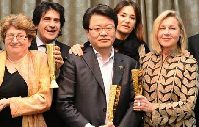Colors of nature
 |
|
The pigments are put in paper packages for sale. Each weighs 3 grams. |
Ancient painters would exchange colors they made. In the Ming Dynasty (1368-1644), a painter surnamed Jiang in Suzhou became famous for the beautiful deep, almost violet blue he made from the indigo plant, which was widely planted in the Taihu Lake regions in Jiangsu.
| The long way home |
The indigo was the most popular color in Chinese painting of mountain-and-water, flower-and-bird and figures. An old Chinese saying that the indigo blue is extracted from the plant but is bluer than the plant, a metaphoric way of saying that the pupil outdoes the master, comes from the color-making practice.
During the reign of Emperor Qianlong in the Qing Dynasty (1644-1911), an offspring of Jiang's family started a workshop producing and selling colors, which became China's first color shop, Jiang Sixutang.
Jiang's color-making techniques passed down for generations and finally to Qiu Qingnian in 1963, when the private-owned shop became national asset in the 1950s.
"I was 20, just graduated from high school. Together with another young man, we apprenticed with our master. The first task was holding the about 3-kilogram-heavy grinding tool to mull the stone powder every day. My colleague could not bear it and gave up two months later," Qiu recalls.
To have a better understanding of painters' requirements for colors, Qiu temporarily left his work to study painting for two years in the mid-1970s.
He became a director of Jiang Sixutang, which turned to a color-making factory. Machines were introduced and tubular paste paint was produced.
For more China Face, here

















